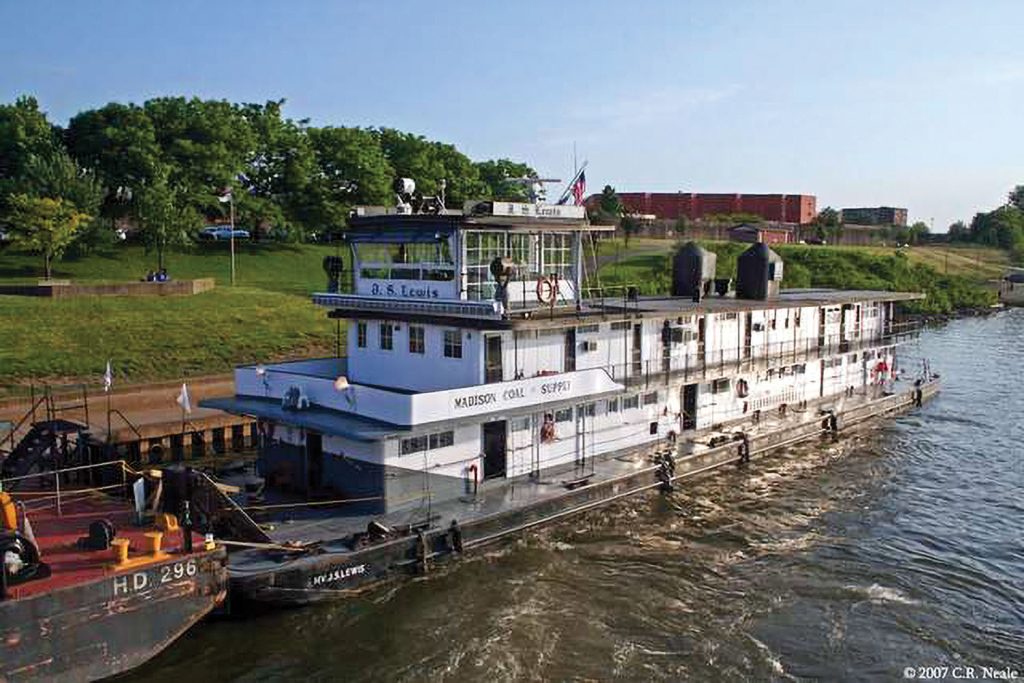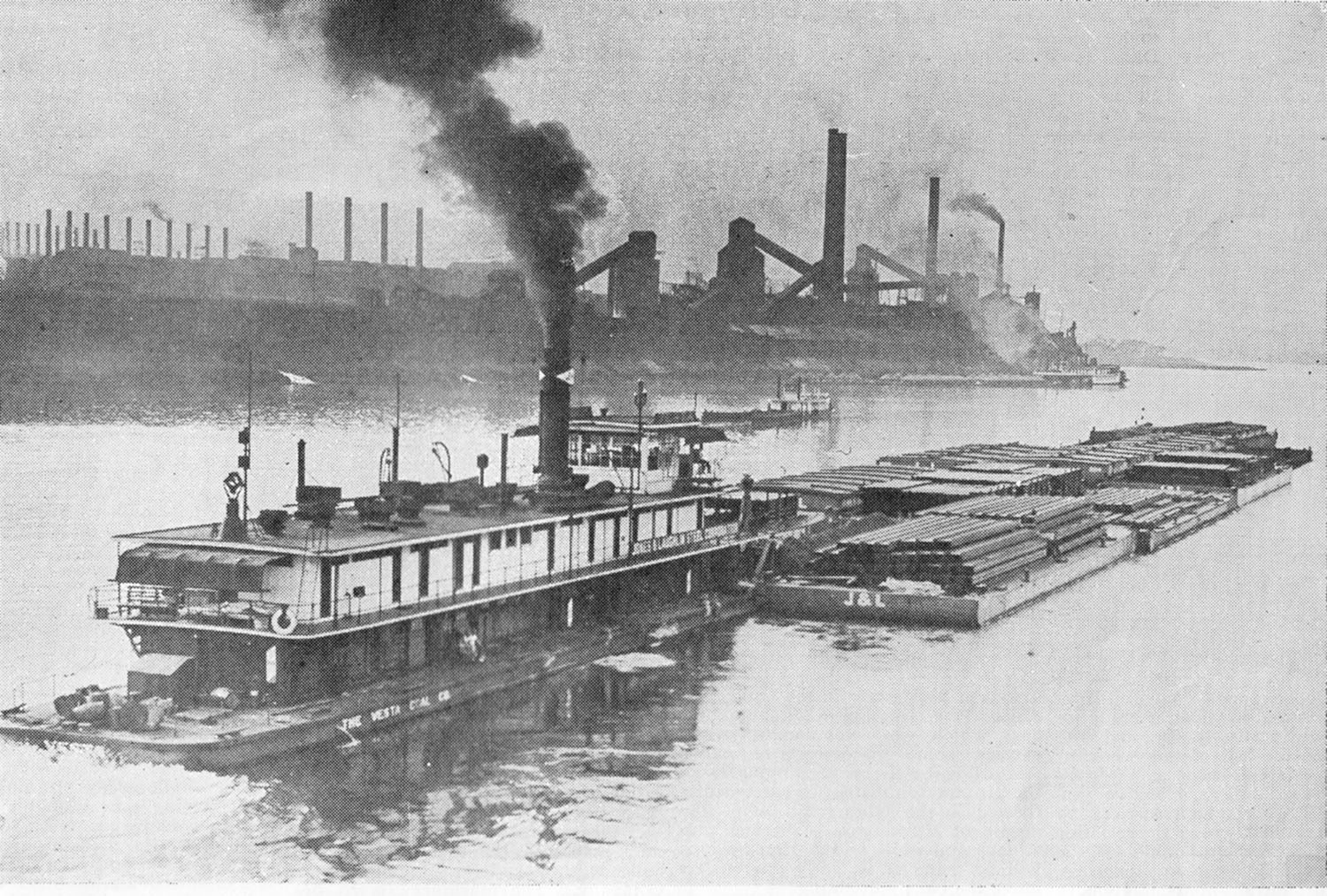As mentioned in this column in the March13 issue, the Jones & Laughlin Steel Corporation (J&L) broke with tradition in 1931 and had two steam prop towboats built for them by the Charles Ward Engineering Works at Charleston, W.Va. The boats were owned by the Vesta Coal Company, a J&L subsidiary. The two boats, named Henry A. Laughlin and Vesta, had steel hulls that were 155.3 by 29.5 feet. The main deck cabin was of steel, and the upper cabin and pilothouse were of wood construction. A single smokestack was located behind the pilothouse. The boats had triple expansion condensing engines, 10’s, 17’s, 21-1/4 – 18 inch stroke, rated at 750 hp. The Babcock & Wilcox steam generators were coal fired. The boats would be utilized primarily between Pittsburgh and points on the Lower Mississippi River, and J&L would never build another sternwheeler.
The Henry A. Laughlin was the first to be delivered in April 1931. There had been a prior steam sternwheel boat of this name owned by J&L, which they had renamed Shannopin in 1930. According to Way’s Steam Towboat Directory, the new Henry A. Laughlin had Capt. J. Gayle Wilson as master. Capt. Graham Varble, who served as a pilot for J&L between Louisville and New Orleans for some 16 years, was lost overboard from the Laughlin near Memphis in 1946. His body was recovered at the foot of Presidents Island on September 20, 1946. The navigation light located at Mile 851.3 on the Ohio River is named in his honor. Capt. Earl “Red” Stiddard, later long with Ohio Barge Line, was a mate aboard the boat at times. In 1952, it was sold to The Ohio River Company and renamed T. R. Workman. It was dismantled in 1954.
The Vesta was delivered to J&L in May 1931, and according to Shipbuilding History, it was the last vessel built by Ward, which had been in business in one form or another since 1872 and building vessels since 1893. The Ward concern had been an early proponent of tunnel stern propeller-driven towboats, but it had also built many traditional sternwheel boats. J&L had an earlier steam sternwheel Vesta that was renamed Hercules in 1930. The new prop Vesta was also in the same run as the Laughlin, and both were often mentioned in the news columns of The Waterways Journal as they journeyed between Pittsburgh and points on the Lower Miss. The Vesta was also feted for performing flood relief work at Gallipolis, Ohio, and Huntington, W.Va., in 1937.
In May 1948, the Vesta was renamed James A. Rankin to honor the recently retired assistant superintendent of river transportation of J&L. (A new diesel twin prop Vesta would be built for J&L by Dravo in 1951.) In July 1952 it was sold to The Ohio River Company, and for the next few years, the sign painters would be kept busy as it was immediately renamed Mike Creditor, then after a new diesel boat of that name came out in 1954 it was renamed ORCO. It would hold this name very briefly, becoming the J.S. Lewis after being acquired by Amherst Barge Company in 1955.
Both Ways and the Inland River Record state that the boat was renamed J.S. Lewis in June 1955, and then sold to Amherst in August of that year. However, I was told personally by Capt. Charles T. Jones, chairman of Amherst Industries for many years, that the boat was sold for scrapping by The Ohio River Company in late 1954 to the Raleigh Junk Company at Sattes, W.Va., about Mile 46.7 on the Kanawha River opposite St. Albans. Someone at the scrap firm called Jones and asked if he would have any interest in the boat. He told that person that he was interested, but since it was just before Christmas he would be unable to get a crew to it until after the holidays. Jones further told him that if they let the boat freeze up he would have no interest. Capt. Jones told me that when he got a crew to the boat they found only one small pipe had frozen and busted; the problem was that in order to keep the boat warm the scrap company had placed several “salamanders,” kerosene or diesel fired heaters throughout the lower machinery spaces. This had placed a thick black coating of soot all over those areas. I once asked if Jones could remember what the purchase price for the boat was. He said, “Oh yes, $15,000.” That would be approximately $170,000 in 2023 dollars.
Amherst placed the boat in operation and used it in towing coal from the Kanawha River to the Hatfield Terminal at Cincinnati. Photos of the boat working as a coal-fired steamer under all of her names show it emitting clouds of black smoke from the single stack. This created a problem when the Smoke Inspectors office of the city of Cincinnati began to register complaints to the company. Capt. Jones told me that the first time he was aware of the existence of photo electric cells to activate lights was when the Lewis went down through the Cincinnati area one day in broad daylight, and her smoke caused all the lights on Columbia Parkway to come on. Letters from the smoke inspectors to Amherst are hanging in the hallway at the offices of Amherst Madison at Port Amherst, Charleston, W.Va. One letter pointedly states that inspectors had been aboard the boat at Hatfield and spoke with the chief engineer about the excessive smoke. The letter says that the engineer stated that “he was doing the best he could with the machinery on the boat.” The writer of the missive then says, “If this is true then it is quite obvious that your machinery needs to be replaced.”
In 1958, Amherst removed the steam machinery and converted the boat to diesel power with the installation of a pair of direct-reversing Enterprise engines of 1,600 hp. Men that had worked aboard it both before and after claimed it was more powerful at 750 steam horsepower that it was at 1,600 hp. diesel. It continued to operate in the coal run from Kanawha River to Cincinnati, and after the sternwheel steamers of the Amherst fleet were done away with, it was the sole line-haul towboat they had until the purchase of the Charleston in 1971. I had the privilege of working aboard it a good bit in the 1980s and enjoyed my times aboard. It was later fitted with a set of Falk 2:1 reduction gears, and after that it was no longer direct-reversible.

Due to the Jones family, primarily the late Capt. Charles Jones and his son Capt. Nelson Jones, who passed away in 2010, the boat is still in existence today. In recent years it has been used primarily for public relations events, not only for Amherst Madison, but for the river industry in general, and thousands of people have been able to tour it at open house events. It never had a reputation as a particularly “fast” boat and when it was still in regular towing service. I once told Nelson that due to the age of the boat, and the fact that it was of partial wooden construction, I took a picture of it every chance I got. He gave me the trademark Nelson Jones grin and said “Well, one thing about it, you have plenty of time to focus!”
Caption for top photo: The str. Vesta departing Pittsburgh with a tow for Memphis in 1935. (WJ, August 31, 1935, David Smith collection)




